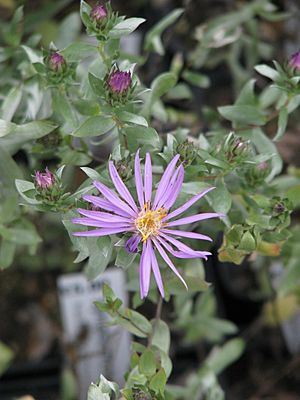Symphyotrichum sericeum facts for kids
Quick facts for kids Symphyotrichum sericeum |
|
|---|---|
 |
|
| In cultivation in England | |
| Scientific classification | |
| Synonyms | |
|
The Western Silver Aster (also called Silky Aster) is a beautiful flowering plant. Its scientific name is Symphyotrichum sericeum. It belongs to the aster family, which includes many well-known flowers like daisies and sunflowers. This plant grows naturally in the central plains of North America.
Contents
Where the Silky Aster Grows
The Silky Aster loves to grow in specific places. You can find it in rocky prairies, which are large grasslands. It also grows in wood glades, which are open areas within forests. Sometimes, it appears on gravel hill prairies too.
This plant is found across a wide area of North America. It ranges from the eastern tallgrass prairies to the Great Plains in the west. It even reaches the foothills of the Rocky Mountains in Texas and New Mexico. You can also find it in the central grasslands of Canada. It's quite rare in the northeastern part of its range. This aster usually sticks to its favorite habitats.
What the Silky Aster Looks Like
The Silky Aster is easy to spot because of its unique silky feel. No other American aster is silky all over! This plant is a perennial, meaning it lives for more than two years. It grows from rhizomes, which are underground stems.
Its main stem stands up straight and sometimes branches out. The entire stem is covered in fine, silky hairs, making it look silvery-grey. The leaves at the bottom of the plant are shaped like a spoon. They have small stalks called petioles. The leaves growing along the stem are oval-shaped. They attach directly to the stem without a stalk. Their edges are smooth, without any teeth or jagged parts. Both the top and bottom of the leaves are silky, giving them a silvery-grey look.
Flowers of the Silky Aster
The flowers of the Silky Aster look quite large compared to the rest of the plant. They grow at the very top of the stem. Each stem usually has a single flower head.
The green parts that protect the flower bud, called involucral bracts, are also silky and oval-shaped. The outer petals, called ray flowers, are a lovely blue color. These are the parts that look like petals. The tiny flowers in the center, called disc flowers, are white. They have yellow to brown stamens, which are the parts that produce pollen. After the flower blooms, it produces a small, dry fruit called an achene.
Protecting the Silky Aster
The Silky Aster is a special plant, and in some places, it needs protection. It is listed as a rare species in Indiana. This means there are not many of these plants left in Indiana. In Michigan, it is considered a threatened species. This means it could become endangered if we don't protect its habitat.

